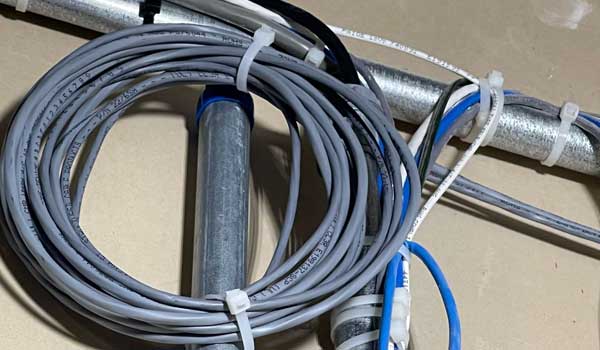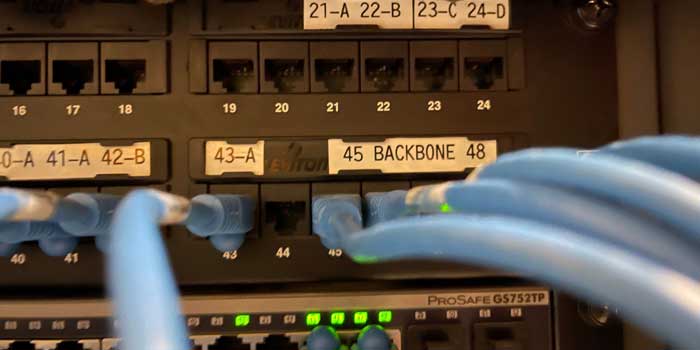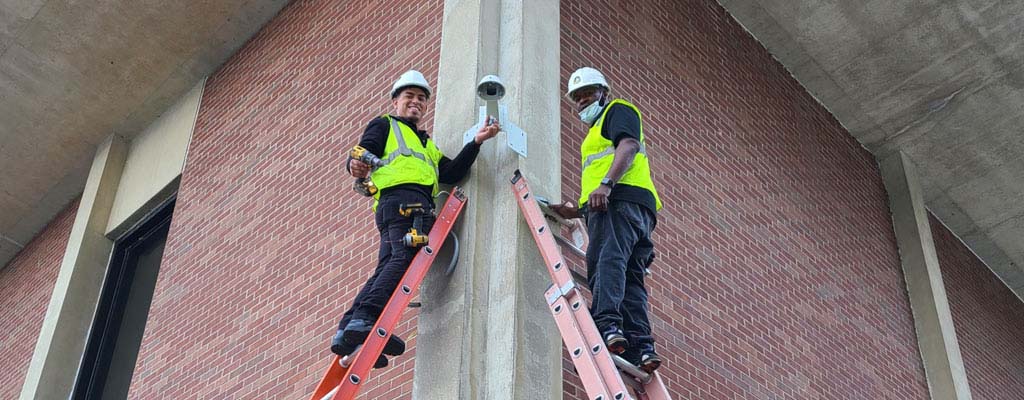Video MGMT System
 Access Control
Access Control
Voice & Data Wiring
 Burglar Alarm
Burglar Alarm
 Fire Alarm
Fire Alarm
Video MGMT System
Voice & Data Wiring
Fiber optic cables are the backbone of the Internet. They make high-speed, high-performance data networking and telecommunications between cities, countries, and continents possible. In fact, whether a person accesses the internet wirelessly, through a traditional cable, or even through a phone line, the data received has traveled through optical fibers at seventy percent of the speed of light.
Yet slowdowns and weak signals still plague Internet users. These connection problems are caused by data bottlenecks inside copper-wire cables that are installed in the "last mile" between offices or homes and an Internet service provider's fiber optic network. Fortunately, it's possible for businesses and property managers to avoid copper cabling entirely by routing optical fibers directly into their properties.

Professional offices and businesses can't afford the slowdowns and unreliability of traditional last-mile cabling. Intensive data transmission from multiple workers is a modern business requirement that can easily be accommodated with a complete fiber network. Videoconferencing, large file transmissions, data backups, and all other telecommunication activities can co-occur seamlessly without lag times or system overloads.
With the growth of online gaming and movie streaming and the rise of remote work and learning, residential property managers are increasingly offering fiber optic Internet as a headlining amenity.
In fact, even many single-family homes are switching to fiber Internet plans to take advantage of their massive bandwidths and speeds. Instead of waiting for programs to buffer on streaming sites, fiber Internet connections can download entire full-length 4K and HD movies in seconds.

Many cities invest in their broadband infrastructure to attract corporations and provide greater connectivity to their workers and students alike. A 2015 study commissioned by the White House found that municipal broadband attracted private investment to underserved communities while reducing Internet service bills for everyone by encouraging competition between service providers.
A fiber optic cable core is a thin glass or plastic tube at the center of the cable that's only slightly thicker than a human hair. This core is where light pulses transmit data using the o/1 binary system of digital electronics. The pulses are produced by either a laser or an LED, and they travel from one end of the fiber core to the other at seventy percent of the speed of light.
Light photons are able to travel long distances despite bends in fiber cables because they are able to bounce off a thin layer of glass cladding that surrounds the core. The cladding keeps the light moving in the right direction without significant signal loss. Were it not for the cladding, the signals would be lost at the first slight bend in the cord.
The primary coating is a layer of relatively thick plastic that, together with strengthening fibers, protects the fiber's cladding and core from excessive bending and tautening.
A cable jacket is the outer layer of protection around an optical fiber cable, the part of the cable that installation experts most often handle. In the U.S., cable jackets are color-coded according to a national electrical code that lets current and future installers know the purpose of each cable cord in a system.

For example, a yellow cable jacket means that a cable is single-mode, and an orange jacket means that a cable is multimode. In more complex multi-fiber cable systems, the code extends to a range of colors with added markings to enable labeling on a legend for each optical fiber.
Cable jackets also feature ratings for properties such as flammability, minimum bend radius, and strength under different stressors. For indoor use of optic fiber cables, aramid yarn secures the fibers against pressures during installation work and future adjustments. Indoor cable jackets must also meet municipal rating standards for fire resistance.
Tight buffer cables with polymer jackets and "loose-tube" fiber constructions are often used in high-pressure, high-stress cabling lines. Breakout cables are a type of tight-buffer cable with extra non-conductive strengthening fibers, a ripcord, aramid yarn, and extra polymer buffering. They secure massive fiber ribbons and subunits in cables routed through extreme environments. In addition to tight buffering, undersea cables also receive solid-barrier support and are often surrounded by water-repellent jellies or water-absorbent powders.

While tight-buffer cables are an essential component of worldwide telecommunications networking, patch cords are essential at the user end of a cable system. They cover short distances and have specialized connectors at each of their ends that are used to plug devices like computers and telephones into routers and Ethernet cable switches.
An optical fiber can be categorized as either multimode or single-mode depending on how many nonrelated pulsing signals it can send through its core. A fiber optic cable as a whole can be categorized as either a simplex or a duplex cable, depending on whether it transmits data in one direction or two.
Multimode optical fibers (MMFs) are able to transmit multiple streams of light pulses through a single core. Their light is usually emitted by Vertical Cavity Surface Emitting Lasers (VCSELs), and the cable diameter of a multimode fiber is usually larger than that of a single-mode cable to accommodate multiple simultaneous pulses of light.
Multimode fiber cables are a good option for single facilities and office towers where a lot of data must be transmitted over a short distance at once. However, utility companies and campuses that require more than ten miles of fiber are wise to invest in single-mode fiber connections.
Single-mode fiber optic cables beam light with laser diodes instead of VCSELs, and they transmit in a single path through the core. Smaller cores enable pulses of light to maintain their integrity over longer distances, which is why single-mode optical fibers can transmit data for up to twenty-five miles without requiring regeneration from amplifiers or other optical signal boosters.
Simplex cables only provide one-way data transmission because they contain a single strand of fiber with a transmitter on one end and a receiver on the other. They're a good choice for CCTV and other monitoring situations that send one-way footage to a central device.
Duplex cables, on the other hand, use two side-by-side fibers, each sending and receiving information in opposite directions for two-way communication. Duplex cables enable reliable telecommunications and are used to connect most high-speed network devices, including servers.
Since nothing is known to travel faster than the speed of light, it should be no surprise that fiber optic cable is the fastest method for data transmittal. The only thing that slows fiber optic networks to seventy percent of the actual speed of light is the refractive index of the glass used to keep the light moving forward through bends in the cable.
Fiber optic cables are also able to accommodate greater bandwidths than traditional cables, allowing for greater information capacity without bottlenecks. Download speeds on fiber networks are often twice as fast as those than can be supported by traditional cable technology. And upload speeds are even more impressive.
While traditional cable uploads take several times longer than downloads, optical fiber cables can upload data at the very same speed that they download. This speed matters, especially when using the Internet for gaming and videoconferencing.
While fiber optic and copper cables both lose signal strength over extended distances, fiber optic cables lose less signal strength because they operate on a higher frequency than their copper counterparts. What's more, because fiber optic technology doesn't conduct electricity, it's less susceptible to the electromagnetic interference that plagues copper-wire cables.
Fiber optic cables are safer than electric cables because they are unlikely to cause electric shocks or start fires. However, because they use infrared laser light, the human eye doesn't naturally blink in reaction to sudden exposure, allowing for severe damage to the eye that isn't noticed until it's too late for correction.
Protective covers over the ends of fiber optic cables, connectors, and ports are therefore necessary to protect customers, and installers should use indirect viewing aids or optical safety filters while investigating fiber cables.
A second significant installation risk involves glass fragments that can appear under the skin after cutting optical fibers. Installers must, therefore, carefully follow safety procedures and disposal regulations when cutting cables with optical fibers.
While fiber optic Internet cabling requires fewer repairs and replacements than traditional cabling, routing cable underground for the "last mile" to a business site or residential building can be expensive in the short term. In addition to safety risks for cabling installation experts, intensive labor is required to dig the trenches that connect individual buildings with a larger fiber optic network.
In fact, the greatest expense of a fiber-to-the-home-or-business installation is in the expense of trenching rather than the expense of the optical fibers themselves. Most installations by telecommunications companies and private businesses, therefore, include many more fibers in their installations than they can currently use to allow for future upscaling without having to dig up and retrench their network.
These extra lines of unused fiber are called "dark fiber." In addition to ensuring plenty of bandwidth for future growth, dark fiber is often leased out by companies to other providers who would like to transmit data through their space.
Traditional cables transmit data in the form of electrons which travel through copper conductors in coaxial cables. By using electrons, these cables are susceptible to electromagnetic interference. Even with shielding, their signals are degraded, and unable to travel long distances. What's more, because electrons take significantly more time to travel than beams of light, traditional cable Internet technologies often feature unacceptable lags and system errors.
Fiber optic technology, on the other hand, transmits information in the form of light pulses that travel through glass optical fibers. Fiber networks can maintain signal strength for up to twenty-five miles before requiring an optic amplifier or repeater.
Fiber optic cable networks that reach directly into businesses and homes support faster data transmission at higher bandwidths than traditional wired cables. Fiber optic Internet connections are famously fast because they rely on light pulses that travel through glass fibers instead of electrons that are conducted through copper wiring. Fiber optic Internet is an exceptional amenity and a wise investment for professional offices, business sites, and large residential properties in which multiple people must have simultaneous access to high-performance data networking.

Our team at Mammoth Security to develop and install the right security solutions to protect your commercial property. From alarms and access control to cameras and cabling, we take pride in what we do, and we’d love to share our expertise and workmanship with you.
If you're ready to take the next step toward securing your property, just fill out the simple form below to set up a free, zero-obligation site consultation. You’ll meet a friendly member of our team as we survey your property, discuss your security concerns, spot points where your security can be improved, and begin to develop a security system that’s expertly tailored to your site’s unique layout and security needs.

Wireless
IP Cameras
Wireless cameras are not reliable enough for commercial use yet. Instead, we use purpose-built antennae to connect hardwired cameras on light poles and buildings.

Phone App
For Camera Systems
Watch live or previously recorded footage on any mobile device. Save it to your phone and e-mail it just like any other video or image.

Increased Resolution
Of 4096×2160
4k or 8MP cameras represent the best value at the moment. Depending on your situation, a 30+ megapixel camera can be installed allowing you to read a seat number from the opposite end of a football field.

Employ The Same Technology As These Companies:


